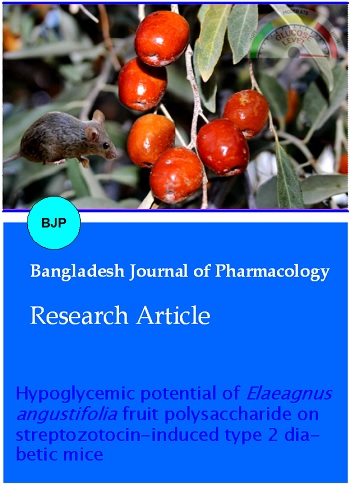Hypoglycemic potential of Elaeagnus angustifolia fruit polysaccharide on streptozotocin-induced type 2 diabetic mice
DOI:
https://doi.org/10.3329/bjp.v13i4.37069Keywords:
Diabetes, Elaeagnus angustifolia, MiceAbstract
In this study, the hyperglycemic potential of Elaeagnus angustifolia fruit polysaccharide in both normal healthy and streptozotocin-induced diabetic mice was investigated. Results showed no significant effect of E. angustifolia fruit polysaccharide on blood glucose level in normal control group, while E. angustifolia significantly suppressed the rise in blood glucose of diabetic mice. In addition, in the first two weeks of administration, the body weight was decreased both in negative control group and E. angustifolia groups, however, E. angustifolia (800 mg/kg) was recovered to the began weight in the fourth week. E. angustifolia (800 mg/kg) could markedly reduce the levels of total cholesterol, triglyceride and improve the level of high density lipoprotein-cholesterol. The results suggest that E. angustifolia could be considered as an ingredient of functional foods for diabetes.
Video Clip of Methodology:
10 min 19 sec Click to watch
Downloads
210
202 Read
69

Published
How to Cite
Issue
Section
License
Authors who publish with this journal agree to the following terms:
- Authors retain copyright and grant the journal right of first publication with the work simultaneously licensed under a Creative Commons Attribution License that allows others to share the work with an acknowledgement of the work's authorship and initial publication in this journal.
- Authors are able to enter into separate, additional contractual arrangements for the non-exclusive distribution of the journal's published version of the work (e.g., post it to an institutional repository or publish it in a book), with an acknowledgement of its initial publication in this journal.
- Authors are permitted and encouraged to post their work online (e.g., in institutional repositories or on their website) prior to and during the submission process, as it can lead to productive exchanges, as well as earlier and greater citation of published work (See The Effect of Open Access).
